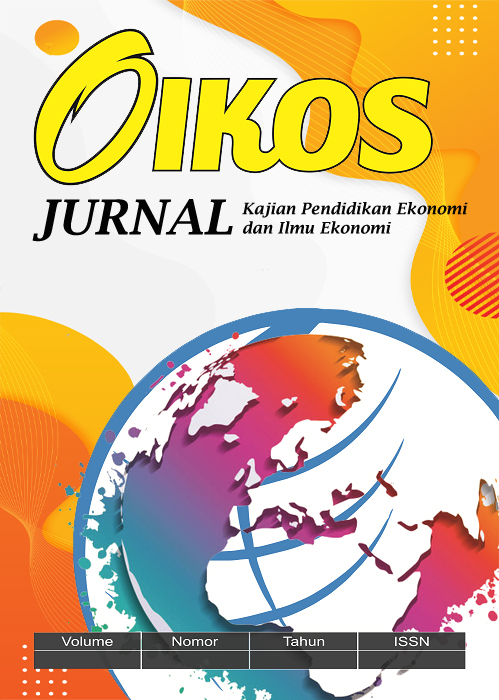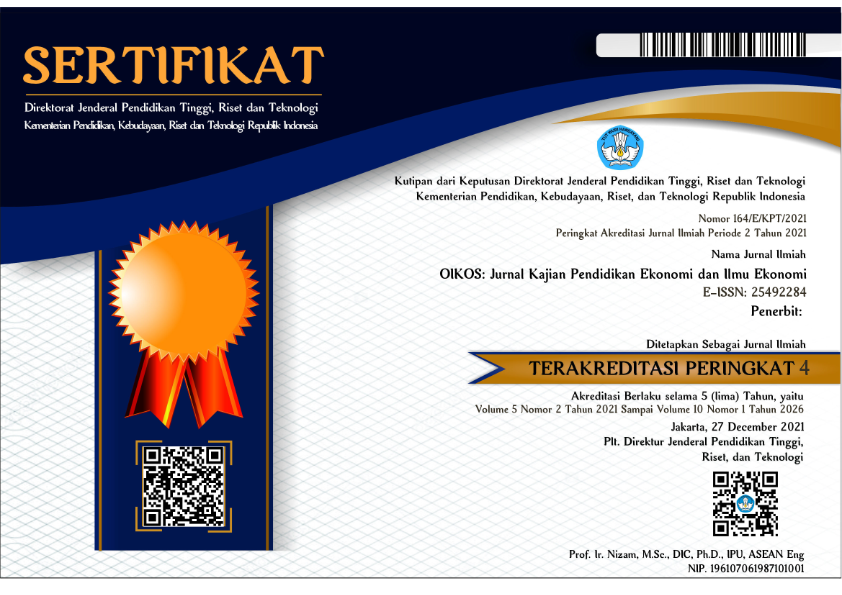EFEK LITERASI FINANCIAL DAN FINANCIAL BEHAVIOR TERHADAP FINANCIAL SATISFACTION
DOI:
https://doi.org/10.23969/oikos.v7i1.6046Keywords:
Literasi Financial, Financial Satisfaction, Financial BehaviorAbstract
This research is motivated by the research of Hayes (2014) and the opinion of financial planning expert Emilie Goldman regarding financial satisfaction. The purpose of the study was to determine the factors that affect the level of financial satisfaction. The research subjects were all students of accounting education at the PGRI University of West Sumatra. Student's financial satisfaction was measured by a questionnaire. The data analysis technique used is inductive analysis using the classical assumption test in the form of normality test, heteroscedasticity test, autocorrelation test, and multicollinearity test. The research hypotheses were tested using the simultaneous effect test (F test) and partial test (t test). The results showed that financial literacy, and financial behavior, had a significant effect on financial satisfaction in accounting education students at the PGRI University of West Sumatra. The implication of this research is that adequate financial literacy is needed to increase financial satisfaction of accounting education students at PGRI West Sumatra University. As well as adequate training in order to improve the financial behavior of accounting education students at PGRI West Sumatra University.
Downloads
References
Emilie Goldman. (2014). Financial Life Plan. Tamarind Financial : California
Easterlin, R. A. (2006). Life cycle happiness and its sources Intersections of psychology, economics, and demography. Journal of Economic Psychology, 27(4), 463–482. https://doi.org/10.1016/j.joep.2006.05.002
Ferreri, C., & Paul, F. (2004). How Important Is Methodology for the Estimates of the Determinants of Happiness? The Economic Journal, 114(497), 641–659.
Plagnol, A. C. (2011). Financial satisfaction over the life course: The influence of assets and liabilities. Journal of Economic Psychology, 32(1), 45–64. https://doi.org/10.1016/j.joep.2010.10.006
Hira, T. K., & Mugenda, O. M. (1999). The Relationships Between Self-Worth and Financial Beliefs, Behavior, and Satisfaction. Journal of Family and Customer Sciences, 91(4), 76.
Long, G. T., Viet, M. H., & Diep, N. T. H. (2016). Gender Differences in Financial Sources and Perceived Financial Satisfaction Among Older People in Vietnam, 18(2), 36–58.
Campbell, A. (1981), The Sense of Well-being in America: Recent Patterns and Trends, McGraw-Hill, New York, NY.
Coşkuner, S. (2016). Understanding Factors Affecting Financial Satisfaction: The Influence of Financial Behavior, Financial Knowledge and Demographics. Imperial Journal of Interdisciplinary Research, 2(5), 2454–1362. https://doi.org/10.1093/comjnl/bxm041
Joo, S. H., & Grable, J. E. (2004). An exploratory framework of the determinants of financial satisfaction. Journal of Family and Economic Issues, 25(1), 25–50. https://doi.org/10.1023/B:JEEI.0000016722.37994.9f
Sohn, S.H., et. al. (2012). Adolescents’Financial Literacy : The Role of Financial Socialization Agents, Financial Experiences, and Money attitudes in shaping financial literacy among South Korean Youth. Journal of Adolescence, 35(4), 969-980. https://doi.org/10.1016/j.adolescence.2012.02.002.
Herdjiono, I., & Damanik, L. A. (2016). Pengaruh Financial Attitude, Financial Knowledge, Parental Income Terhadap Financial Management Behavior. Jurnal Manajemen Teori Dan Terapan, 9(3), 226–241.
Kholilah, N. Al, & Iramani, R. (2013). Studi Financial Management Behavior Pada Masyarakat Surabaya. Journal of Business and Banking, 3(1), 69–80. https://doi.org/10.14414/jbb.v3i1.255
Consumer Financial Protection Bureau. (2015). Measuring Financial Well-Being: A Guide to Using the CFPB Financial Well-Being Scale. https://www.consumerfinance.gov/. https://doi.org/10.1111/joes.12124
Barclays. (2014). A Summary of Financial Well-Being : The Last Taboo in The Workplace?
Joo, S. (2008). Personal Financial Wellness Scale. Springer, 22314–22314.
Sheng, M. S. J., Kiak, T. K., & Soon, T. E. W. W. (2013). The Ompact of Demographic Factors and Financial Satisfaction of Bequest Motives Among Eldery in Selangor, Malaysia. Universiti Tunku Abdul Rahman, 84(April), 487–492. Retrieved from http://ir.obihiro.ac.jp/dspace/handle/10322/3933
Rutherford, Fox. 2010. Financial Wellness of Young Adults Age 18-30. Family and Consumer Sciences Research Journal. Volume 38 Issue 4.
Rasyid, R. (2012). Analisis Tingkat Literasi Keuangan Mahasiswa Program Studi Manajemen Fakultas Ekonomi Universitas Negeri Padang. Jurnal Kajian Manajemen Bisnis, 1(2), 91–106.
Sahi, S. K. (2013). Demographic and socio-economic determinants of financial satisfaction. International Journal of Social Economic, 40(2), 127–150. https://doi.org/http://dx.doi.org/10.1108/03068291311283607
Ross et al. (2016). Pengantar Keuangan Perusahaan (Edisi Global Asia). Jakarta: Salemba Empat.
Hasibuan, B. K., Lubis, Y. M., & HR, W. A. (2018). Financial Literacy and Financial Behavior as a Measure of Financial Satisfaction. Advances in Economics, Business and Management Research (AEBMR), 46(January), 503–507. https://doi.org/10.2991/ebic-17.2018.79
Xiao, J. J., & O’Neill, B. (2016). Consumer financial education and financial capability. International Journal of Consumer Studies, 40(6), 712–721. https://doi.org/10.1111/ijcs.12285
Russely, I.D.P, Fransisca, Y., dan Zahroh, Z.A. 2014. Analisis Pengaruh Pembiayaan Mudharabah dan Musyarakah terhadap Tingkat Profitabilitas (Return On Equity) Studi pada Bank Umum Syariah yang terdaftar di Bank Indonesia periode 2019-2012. Jurnal Administrasi Bisnis. Malang: Universitas Brawijaya
Downloads
Published
Issue
Section
License
Copyright (c) 2023 Oikos : Jurnal Ekonomi dan Pendidikan Ekonomi

This work is licensed under a Creative Commons Attribution 4.0 International License.









